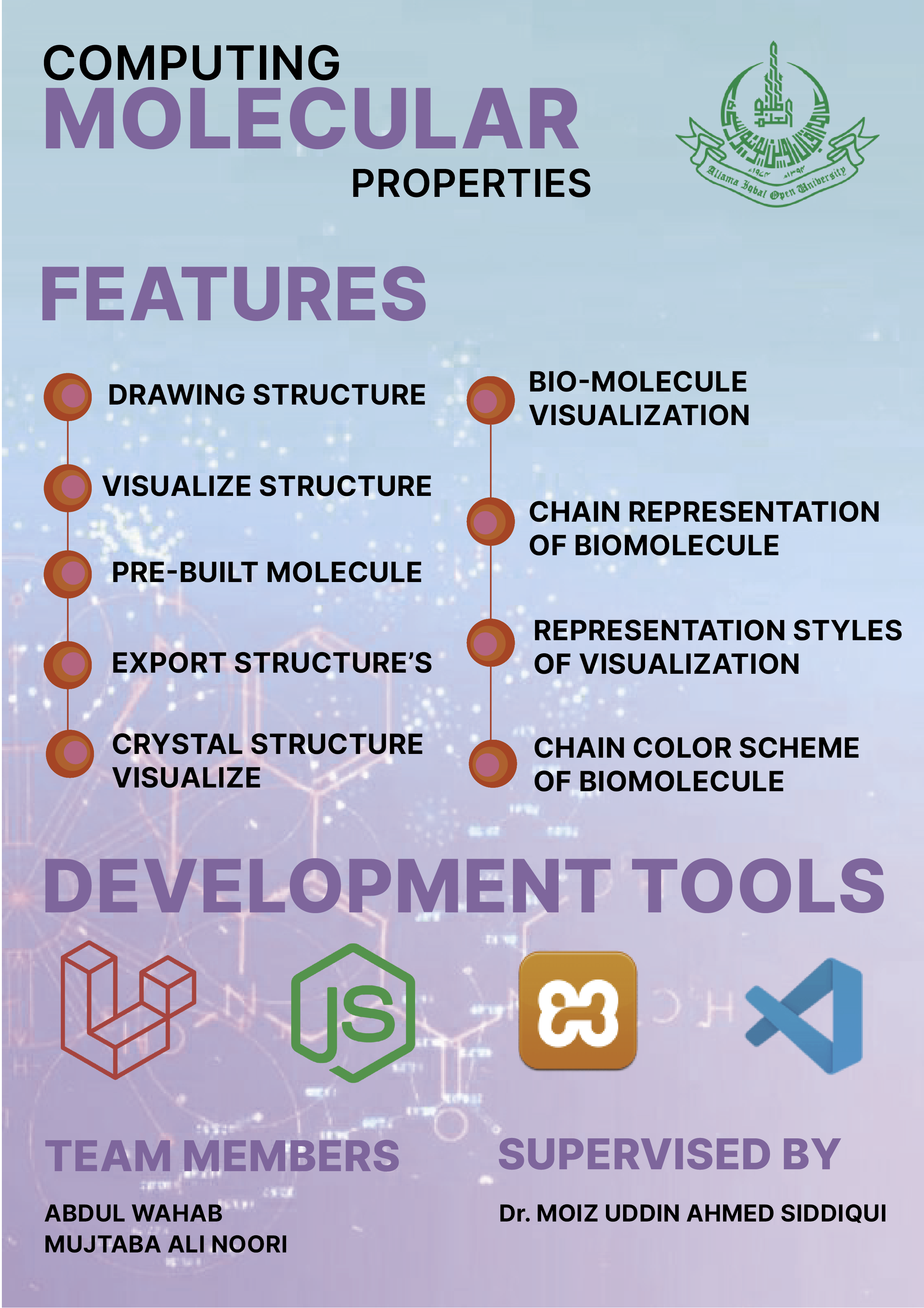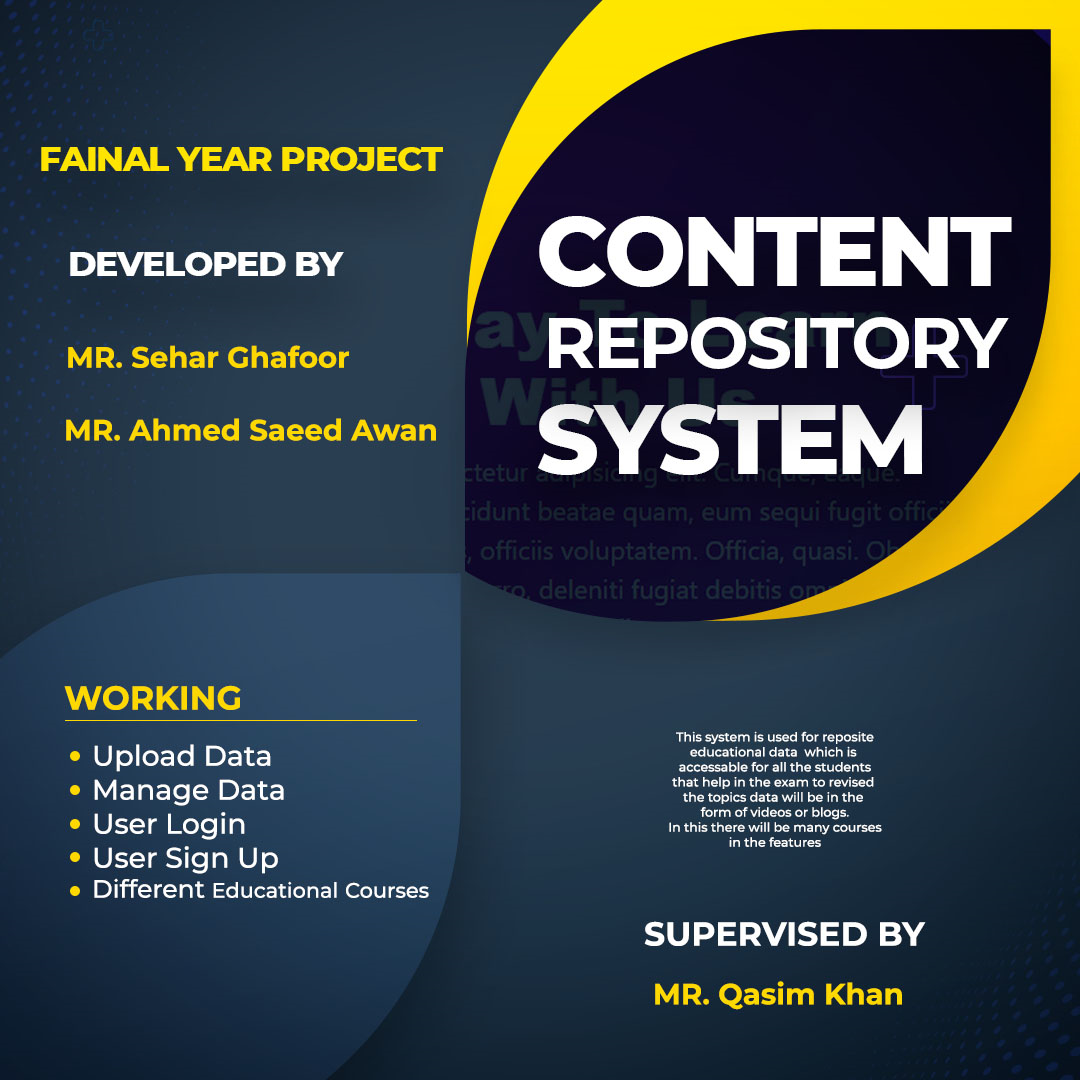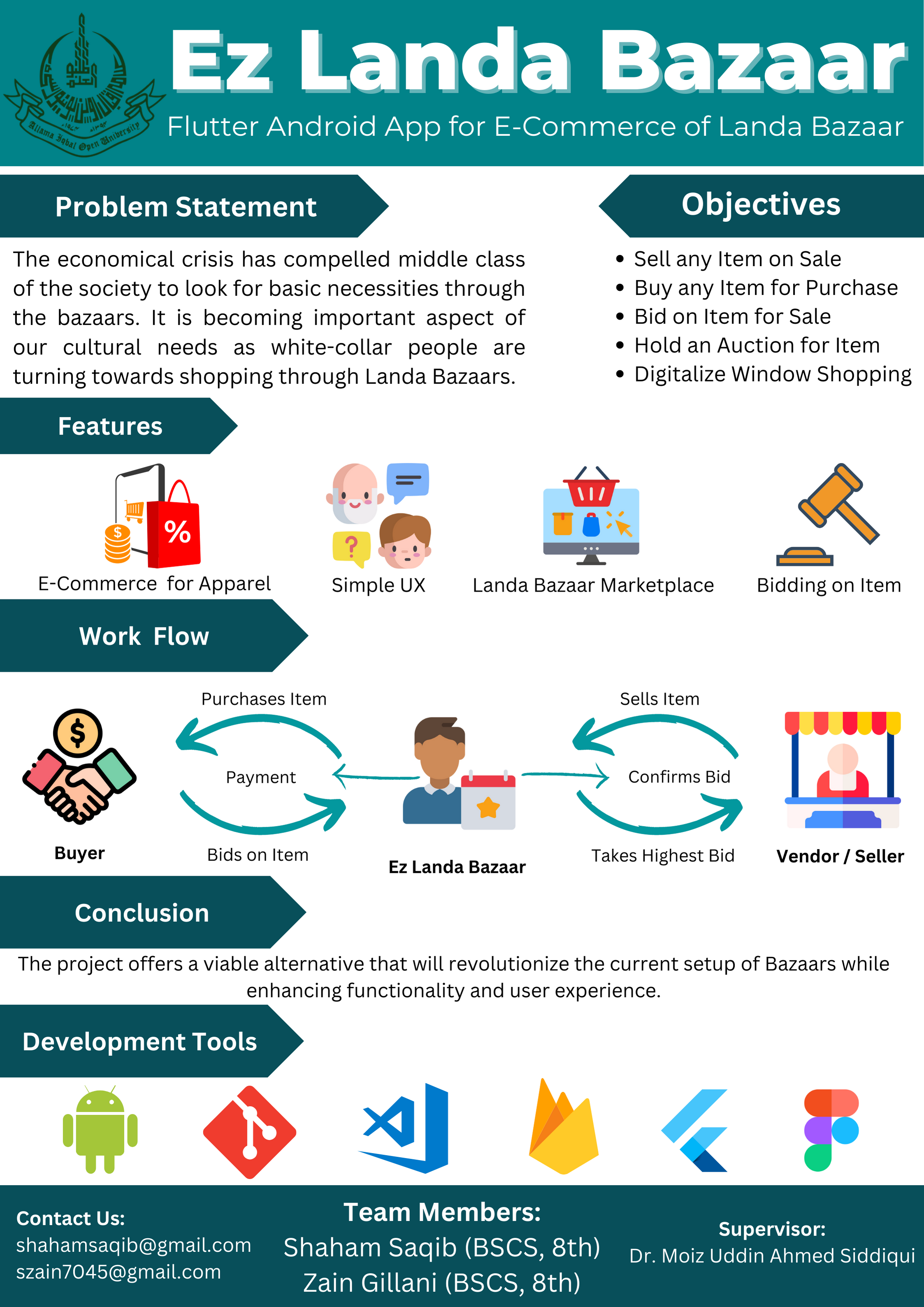CS_Project
Final Year Project Showcase
Project 2023
Problem Description
The existing systems for computing and drawing molecular properties are proprietary and very expensive in price. Most of the systems are based on stand-alone applications and can only be executed in a controlled environment. Furthermore, computing properties and drawing structures are available in the package of two different systems. The proposed software application takes up these challenges and provide a web-based system for computing and drawing molecular properties online.
Objectives
Objectives of this system is to;
- Develop a single consolidated system for molecular drawing, visualization, and computing molecular properties.
- Develop a web-based version of the system with the above-mentioned features.
Computational Chemistry is an emerging field that provides tools and techniques for performing chemical reactions and calculations. It makes use of set of simulation tools for modeling organic objects and solving chemical problems and a wide variety of tools are available in this regard. Majority of the tools are proprietary with high cost and out of reach of the students. Furthermore, a wide range existing applications are standalone and therefore, not available online for anywhere and anytime access. Keeping view of these challenges the project named as COMP (Computing Molecular Properties) proposes a web-based solution to overcome the challenges of existing systems. It provides the features of molecular structure visualization, analysis, and property calculations. It offers a user-friendly interface for designing and exploring molecular structures, bridging the gap between theory and practice in computational chemistry. It enables users to interactively analyze and investigate chemical molecules, visualize them in three dimensions, and perform various calculations through a single consolidated system. It also supports the examination of biomolecules and provides features such as importing pre-built molecular templates and exploring complex chemical events. The application is aimed at students, researchers, and teachers in the field of chemistry, facilitating their learning, research, and teaching activities. The proposed system has been developed by following Extreme Programming methodology and emphasizes on performance, accessibility and usability.
Problem Description
The content repository system addresses various challenges associated with content management. Organizations often struggle with content scattered across different platforms, leading to difficulties in locating and collaborating on important files. Lack of version control makes it hard to track changes and manage revisions efficiently. Data security is a concern, with content susceptible to unauthorized access and potential breaches. Without a centralized repository, content management becomes inefficient, hampering productivity. Backup mechanisms are often inadequate, risking data loss in case of system failures or disasters.
Objectives
Implement a centralized content repository system Improve content accessibility and discoverability: Enhance collaboration and workflow efficiency Ensure content security and access control.
Foster user adoption and provide training Evaluate and monitor system performance Align with industry standards and compliance
The content repository system is an essential tool that serves as a centralized and secure hub for managing digital content. It provides users with a unified platform to store, organize, and access various types of content, such as documents, images, videos, and more. Through robust version control mechanisms, the system enables users to track changes made to content over time, facilitating efficient collaboration and streamlining workflow processes. Additionally, the content repository system ensures data protection through stringent access controls, allowing only authorized personnel to view, edit, or delete content. Scalability and integration capabilities make it possible to accommodate growing content volumes and seamlessly connect with other software tools used within the organization. Moreover, the system prioritizes data backup and compliance, ensuring data integrity and adherence to legal and regulatory standards. With an intuitive user interface and valuable insights derived from analytics, the content repository system empowers organizations to optimize their content management strategies, enhancing overall productivity and efficiency.
Problem Description
Combines key logger-based storage, steganography, SVD-enhanced protection, and ethical considerations for advanced data security and ethical handling in response to escalating cyber threats.
Objectives
- Research and Analysis
- System Design
- Keylogger Development
- Data Encryption and Concealment
- Singular Value Decomposition (SVD) Integration
- Image Encryption
- System Integration and Testing
- Ethical Considerations and User Consent
- Evaluation and Comparison
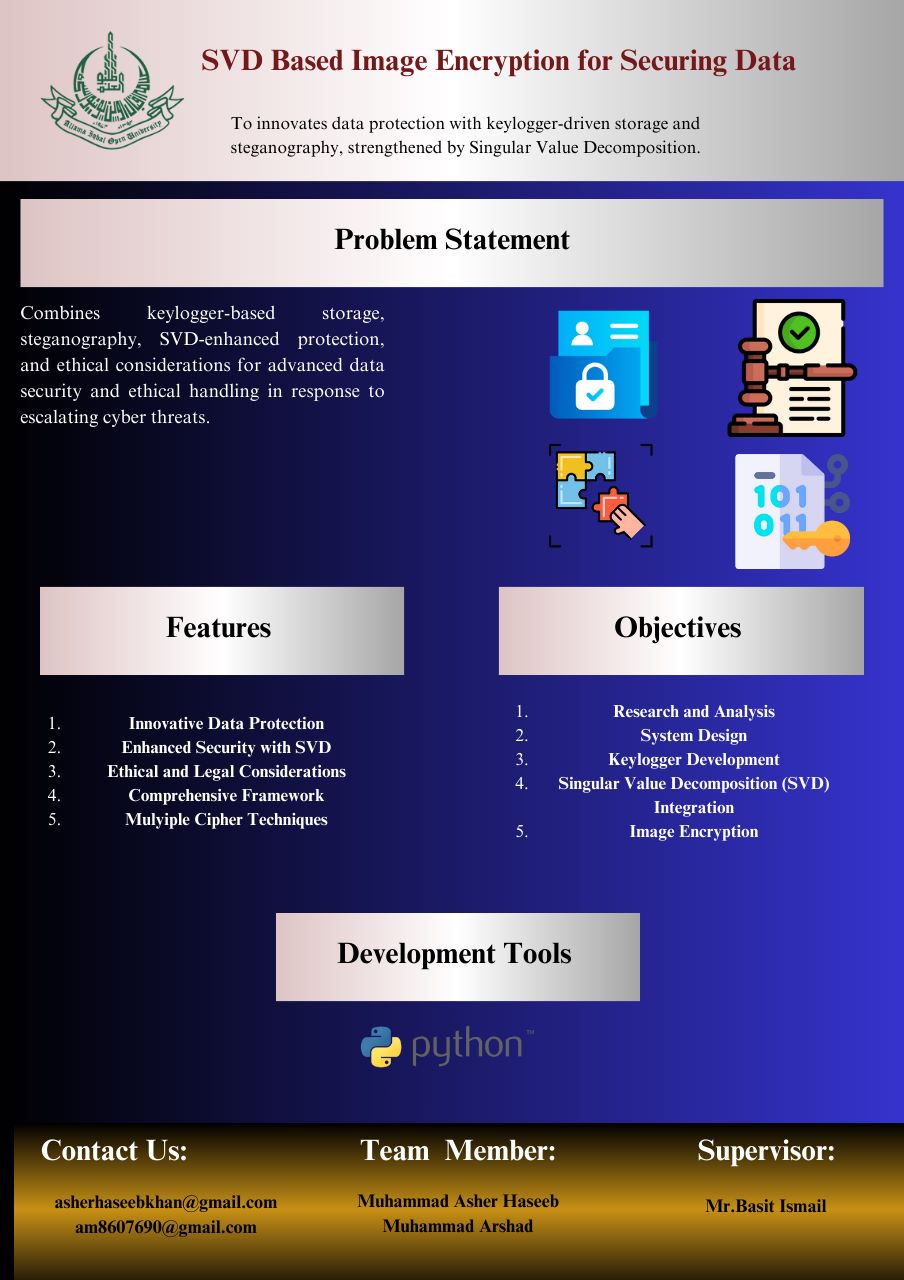
This Project describes the creation of a covert and secure keylogger application that records keystrokes from users and uses Singular Value Decomposition (SVD) methods to encrypt the data for storing within pictures. The main goals are to guarantee data security, effective storage, and powerful encryption. The application will be created using the appropriate libraries and encryption techniques in the programming language of choice. The acquired data can be transmitted and stored securely thanks to the SVD-based picture encryption. The keylogger's functionality, dependability, and security will be rigorously tested and evaluated. The importance of moral concerns and legal compliance will encourage responsible use for acceptable reasons. Keywords: cybersecurity, data encryption, SVD, image encryption, keylogger, and keystroke capture.
Problem Description
Most of the existing systems are proprietary and thus expensive to be used by the academia. There are some open-source systems, but they are providing limited set of features with static set of structure and pre-defined questions. The Quiz Score has taken up these challenges and provide a robust assessment system to facilitate the process of teaching and learning. It has a databank of multiple-choice questions with a defined difficulty level to accommodate different levels of learning. It can be used both by teachers and students to prepare and participate online tests, respectively.
Objectives
Following are the main objectives of Quiz Score System:
- Enable the teachers to prepare online tests based on MCQs of varying difficulty levels.
- Allow the student to take online tests as per their own learning pace.
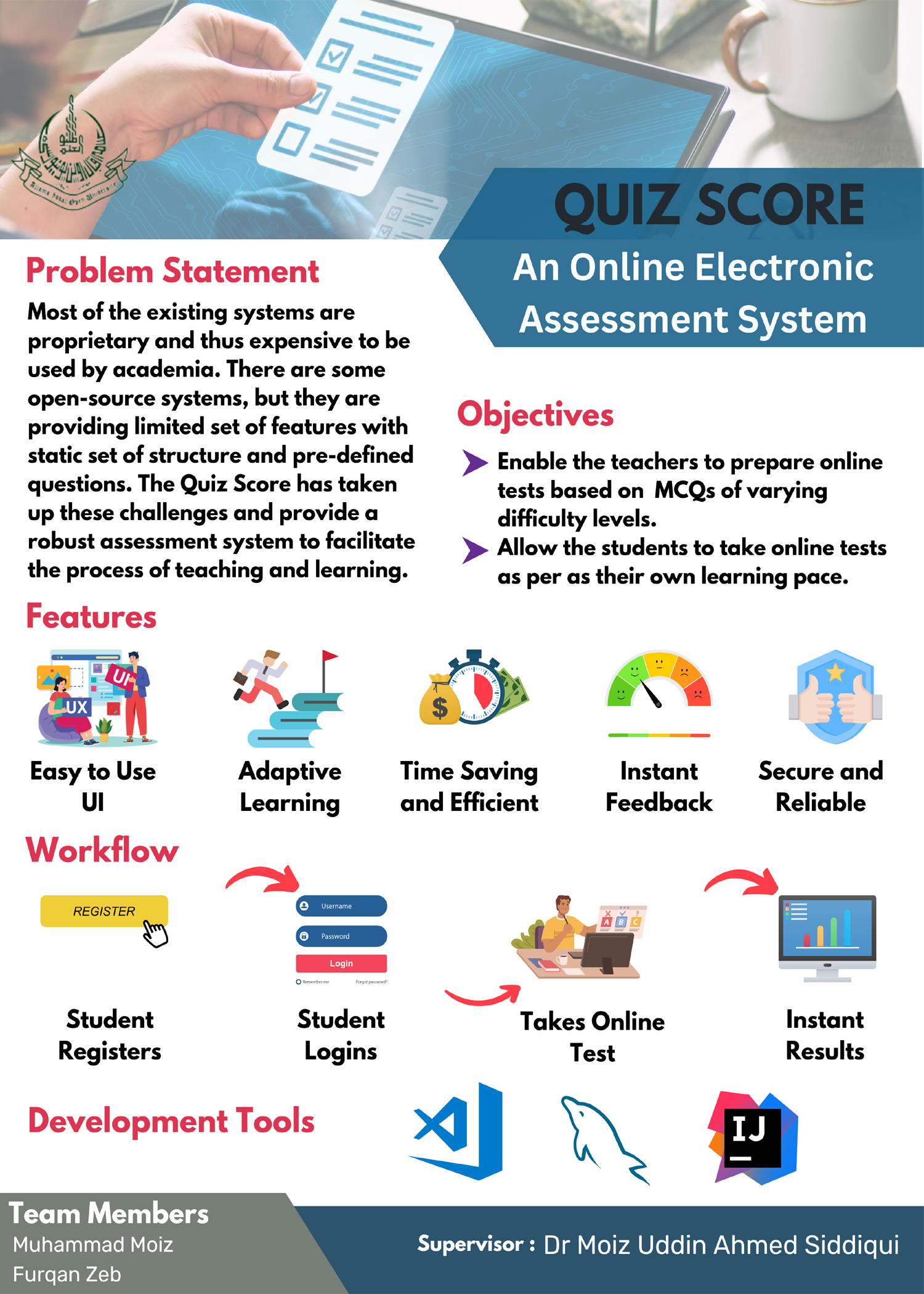
Quiz Score is a web-based system that allows teacher to prepare online tests of varying difficulty level and students to participate and take quizzes on their own learning pace. The system focuses on administering quizzes of multiple-choice questions (MCQs), requiring students to respond within a predetermined amount of time. It aims to simplify the evaluation process and enhance the learning experience by embracing technology and incorporating features that address the limitations of existing systems. It provides teachers with accurate results and immediate feedback to students by automating the assessment process.
Problem Description
The problem statement for the Urdu Dictation: A Speech-to-text Application is that Urdu speakers face challenges in inputting text due to the complexity of the Urdu script and their limited typing skills. In addition, some applications do not allow users to take pauses while speaking Urdu text. This makes it difficult for them to communicate effectively in written Urdu, especially in situations where typing may not be feasible, such as when using a mobile phone or when there is limited time
Objectives
- To identify words of the Urdu language spoken by anyone and convert the min to text.
- To make the application more User friendly and easy to use.
- Free of cost.
- To allow user to take pauses while giving input and again resume from the same stage where user left.
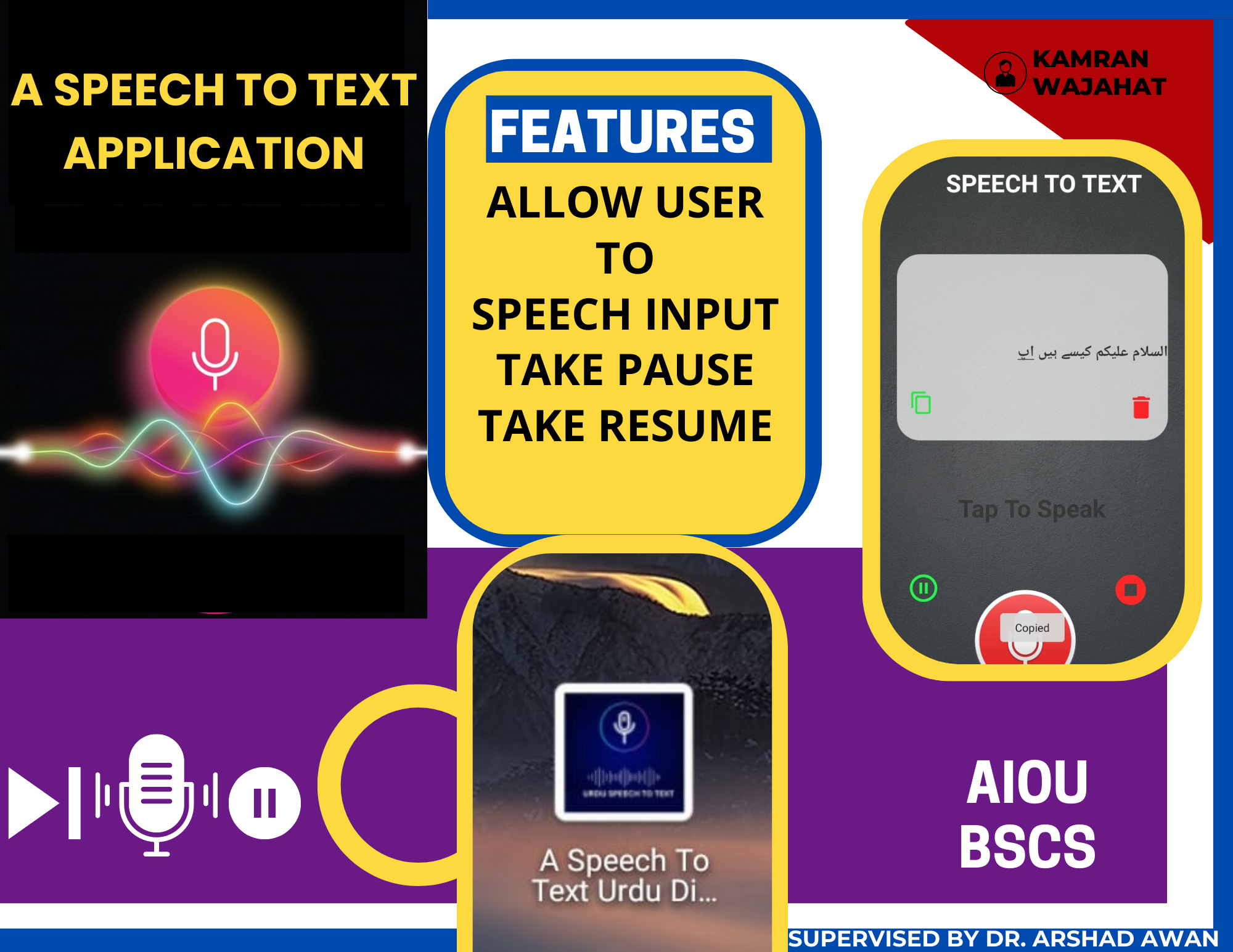
The project named Urdu Dictation is a software application that can recognize spoken Urdu language and convert it into written text. It aims to provide a convenient and efficient way for Urdu speakers to input text into their devices by speaking instead of typing. The interaction with computers or gadgets is faster, simpler, and easier, through voice or speech instead of typing through the keyboard or console, so the people will prefer Speech-to-text Application. Speech-to-text Application will facilitate the users in workplaces, in marketing, in banking, in health care, in language learning, and in the education field. This project aims to design and the implementation a Speech Recognition System for the Urdu Language. This project can be especially beneficial for individuals who have difficulty typing, or for those who prefer to use spoken language as their primary means of communication.
Problem Description
The existing manual system of the Establishment Section 1 & II in the Registrar Department involved several challenges that need to be address: Time-consuming process Accruing of human error limitation of system, Generating, and updating new and existing employee information of AIOU manually and Generating reports of new and existing employees of AIOU manually.
Objectives
- To Solve the existing problem
- To preserve and maintain the system data.
- To prevent duplication of data.
- To ensure the accuracy of the system
- To ensure the integrity, security, and reliability of the system
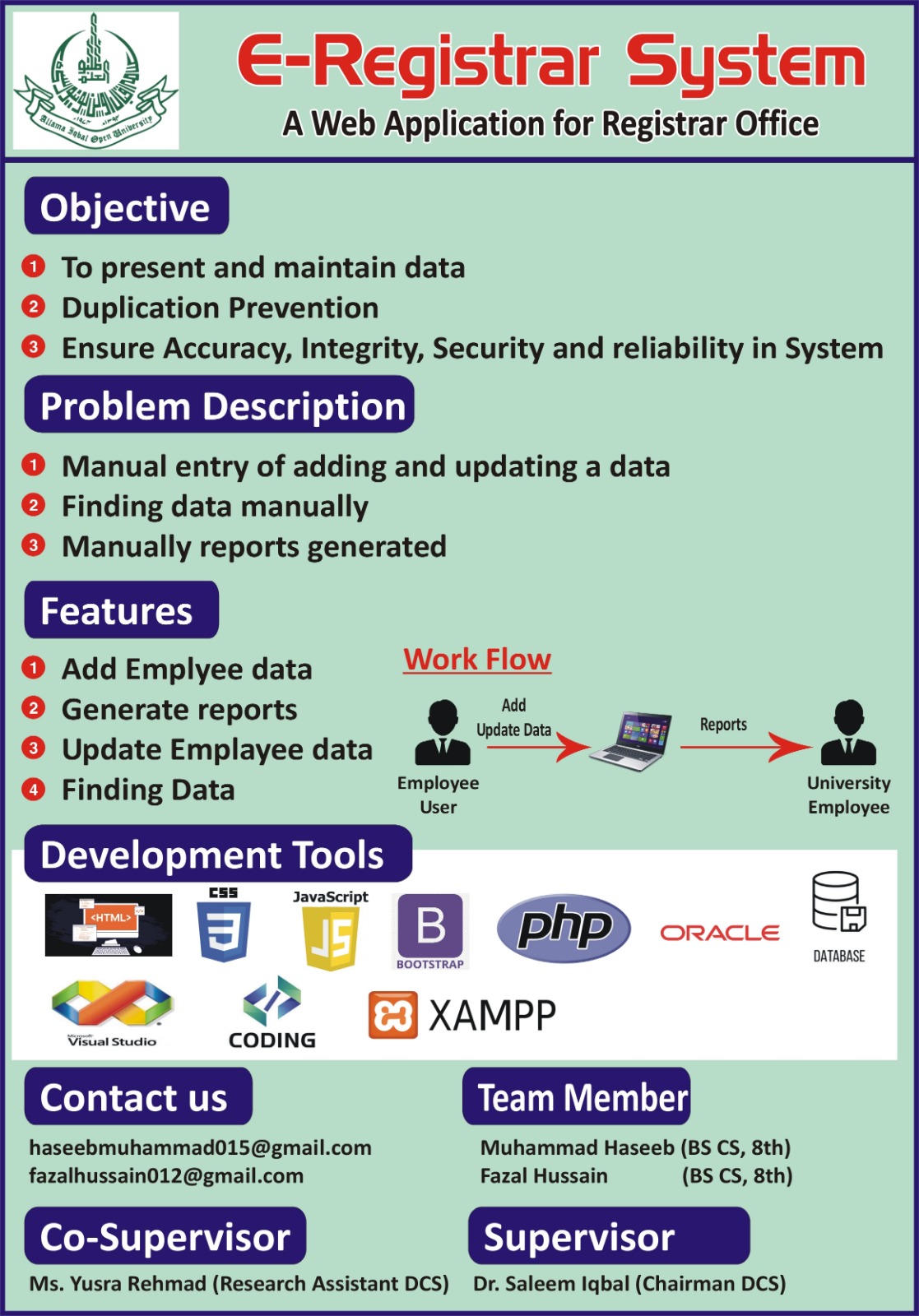
The proposed system is a web-based application. Users will be able to access the system through all mobile phones, tablets, laptops, and Desktop pcs. These web-based application solutions have a customized new interface that is designed according to the requirements of the Registrar Department. The proposed system provides timely and speedy solutions on mobile and desktop platforms as this is also a vital requirement of the system. This application is available 24/7. Its GUI is easy to use and userfriendly. The focus of this project is to maintain records of AIOU employees and generate reports
Problem Description
Career counseling is offered through conferences, group meetings, or one-on-one sessions, however students found it difficult to voice their concerns since they were uncomfortable among others. A system is required that will offer a personal platform for users to assess themselves and receive advice for their course by receiving a road map to reach their goal.
Objectives
- To offer a career road map to college students.
- To guide college students toward their objectives and give them the tools they need to cross a milestone utilizing a single platform.
- To help university students choose their academic path without encountering career-related problems.
- User-friendly user interfaces and machine learning algorithms will be helping students based on their interests. To deliver university information in one click, based on a machine learning algorithm.
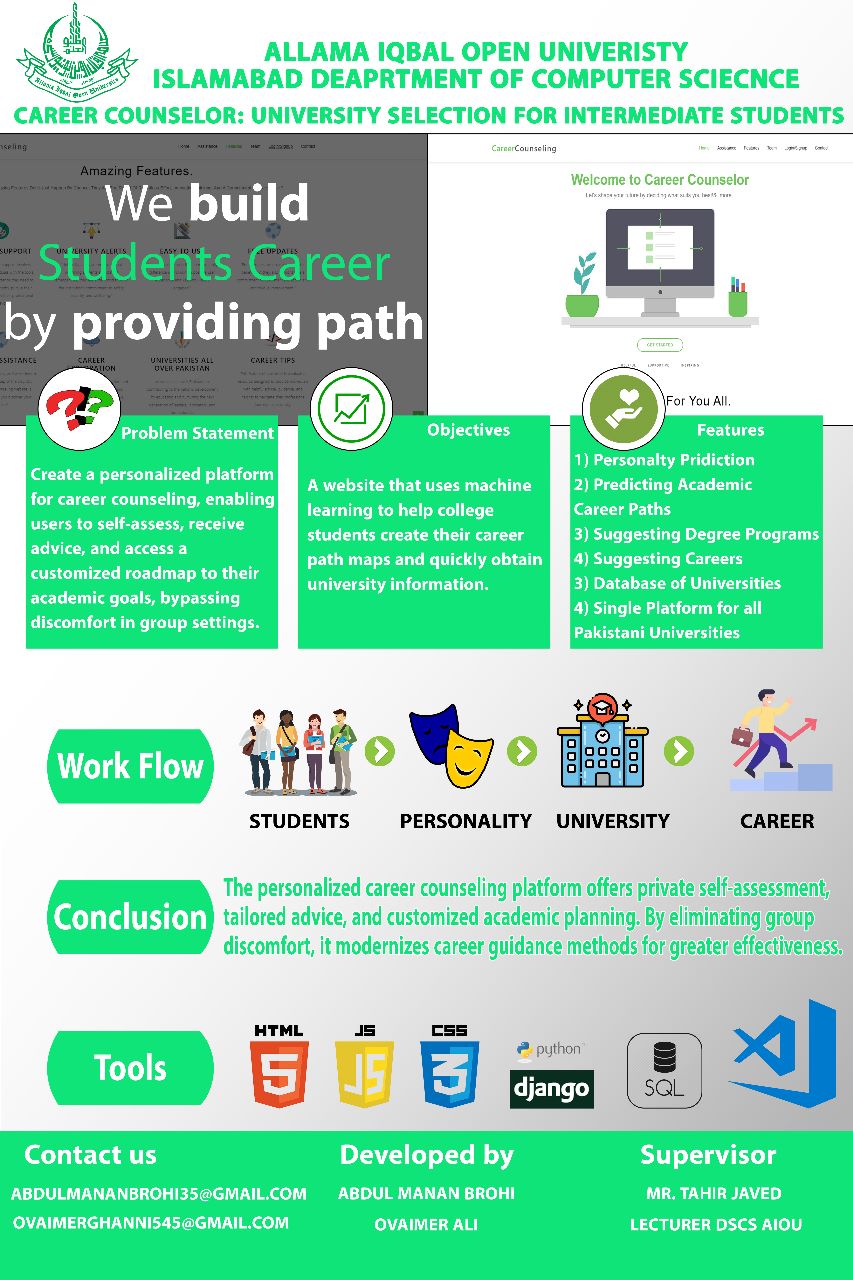
The Machine Learning-Based Web Application for Career Counseling's user manual offers thorough instructions for utilizing it. Users can obtain tailored career counselling, research universities, create roadmaps, make use of counseling techniques and resources, and make decisions about their academic and professional routes by adhering to these rules. Through a user-friendly interface, the application seeks to empower users as they make professional decisions.
Problem Description
The challenge is to create quick 3D model production workflow using software programs like MAYA ,PolyCam and MATLAB. PolyCam is a camera tracking programmed that can extract camera characteristics from video or image sequences.Applications in science and engineering frequently used MATLAB,a potent programming language and development environment.
Objectives
- Developed a user-friendly interface
- Including geometry creation, texture mapping, lighting setup, and rendering
- Optimize performance and efficiency in 3D model generation.
- To enhance efficiency and productivity
- Flexibility
- Integration
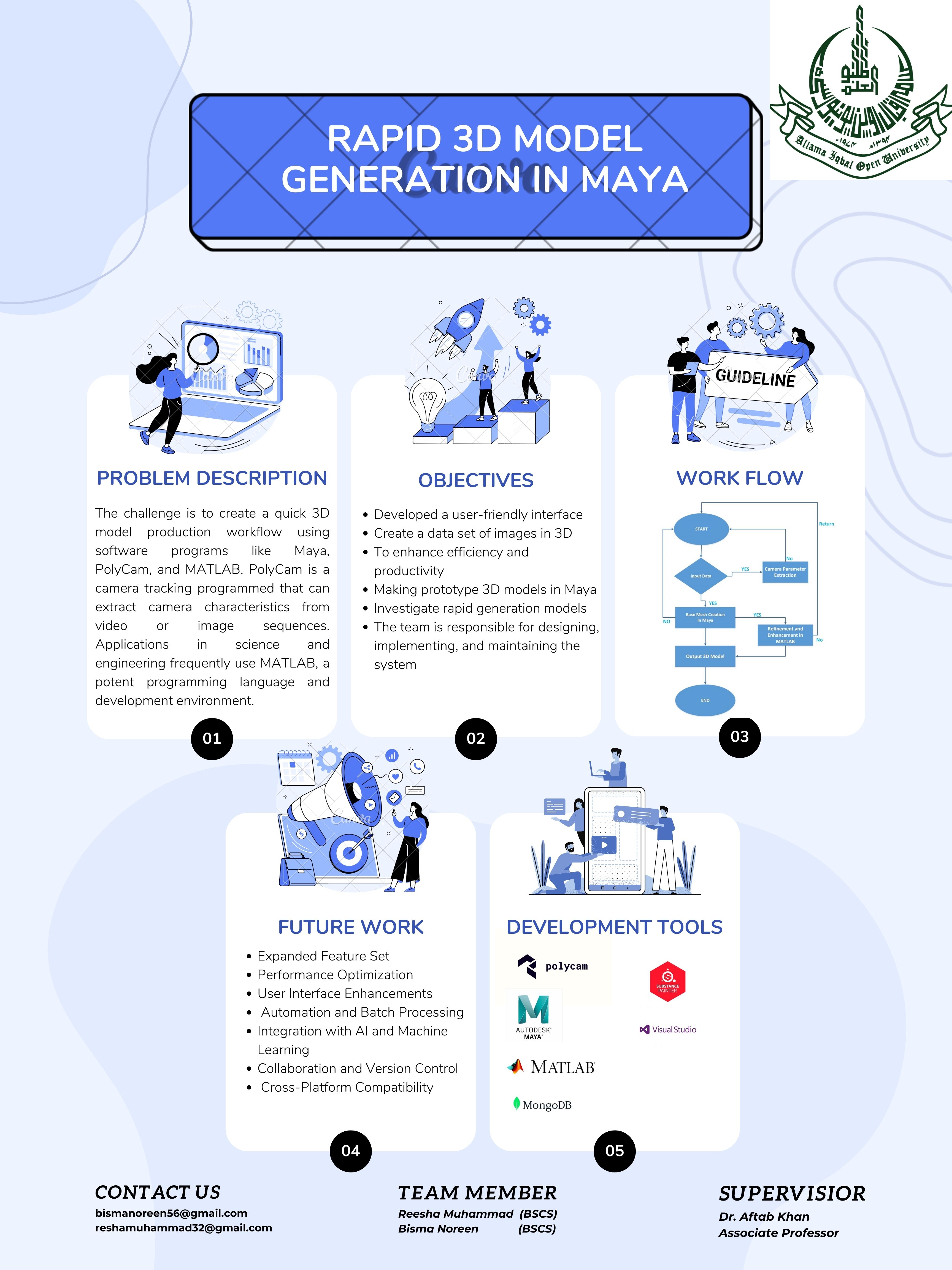
The project's goal is to offer a workable solution for quick and effective 3D model generation using easily accessible software and hardware while ensuring the quality of the final 3D model, such as examining and validating the model for overall accuracy and consistency. . MATLAB, Maya, and Polycam make up the three primary parts of the suggested system.The project’s aim is to develop a rapid 3D model generation using Maya, Polycam, and a 3D turntable. They enable the quick and efficient creation of high-quality 3D models for use in various applications such as animation, gaming, education, and product design. Maya uses as the primary 3D modeling software, providing a range of tools for creating complex geometry and textures. Polycamis used for photogrammetry, capturing real-world objects and environments as 3D models. MATLAB was used to create a 3D point cloud. This might entail actions like importing photographic data, producing depth maps or other data, and producing point cloud data.
The economical crisis has compelled middle class of the society to look for basic necessities through the bazaars. It is becoming important aspect of our cultural needs as white-collar people are turning towards shopping through Landa Bazaars.
Objectives
Objectives of this system is to;
- Develop a system for the sale and purchase of used items.
- Allow sellers to bid on any item for sale
- Allow buyers to browse the item list and place the order for purchase.
"Ez Landa Bazar" is an android-based flutter e-commerce application that aims to create marketplaces for the sale and purchase of pre-owned items, with a specific focus on clothing and apparel. The project addresses the inconvenience and time-consuming nature of physical Landa Bazaars by providing an online platform where users can easily search, browse, and choose items from an inventory. The application allows users to sell their used items by creating listings and specifying the minimum and maximum prices at which they want their products to be sold. Buyers can browse through the inventory, contact sellers, and purchase items directly from them. A unique feature of Ez Landa is the option for users to place bids on any specific item, creating a competitive environment and enabling sellers to get the best possible price for their products.
Online shoppers frequently encounter challenges such as slow website loading times, leading to a frustrating user experience, and increased bounce rates. This not only hampers customer satisfaction but also impacts online retailers' conversion rates and revenue.
Objectives
Objectives of this system is to;
- Designing and implementing ONSHOPI as a shopping system.
- Offering a cost solution, for managing customer orders.
- Creating a user platform where customers can conveniently purchase a range of products online.
- Developing a database to store information about various products and services. Ensuring that the system is easy to navigate and use for all users.
- Making sure that the system is both user-friendly and practical in nature.
- Implementing strategies for managing customer orders with efficiency.
- Providing real-time updates regarding product availability, to customers promptly. Ensuring that all online transactions conducted through ONSHOPI are secure and protected.
- Enabling customers to track their orders in time providing them with peace of mind and convenience.
- Giving customers the opportunity to share their thoughts and experiences by leaving product reviews and ratings.
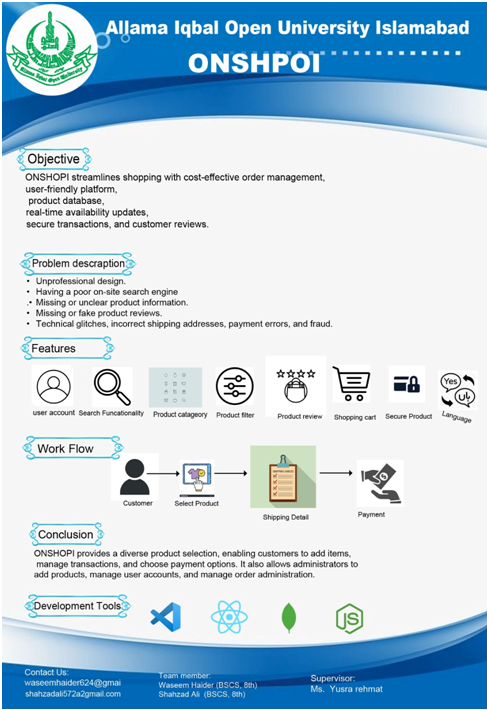
The ONSHOPI platform allows consumers to purchase items and goods from a web store, offering a user-friendly interface and search engine. Its main feature is an interactive search query, allowing users to find items and modify results. Users can view product specifications, read reviews, and write their own reviews. The platform also features a drag-and-drop function for managing inventory. The user-friendly search engine efficiently shows results and simplifies the administrator's process of managing the online marketplace.
Career club members often struggle to access relevant and up-to-date resources, networking opportunities, and career development guidance, leaving them without a clear path for advancing their professional goals. This lack of support hinders their career growth and diminishes the club's overall effectiveness in fostering successful careers.
Objectives
- To provide a centralized platform for job seekers and employers to connect with each other.
- To help job seekers find relevant jobs that match their skills and experience.
- To help employers find qualified candidates for their open positions.
- To streamline the job application process for both job seekers and employers.
- To provide a secure and user-friendly platform for job seekers and employers to interact with each other.
- To collect and analyze data on job trends and hiring patterns.
- To provide job seekers with resources and tools to help them with their job search.
- To promote diversity and inclusion in the workplace.
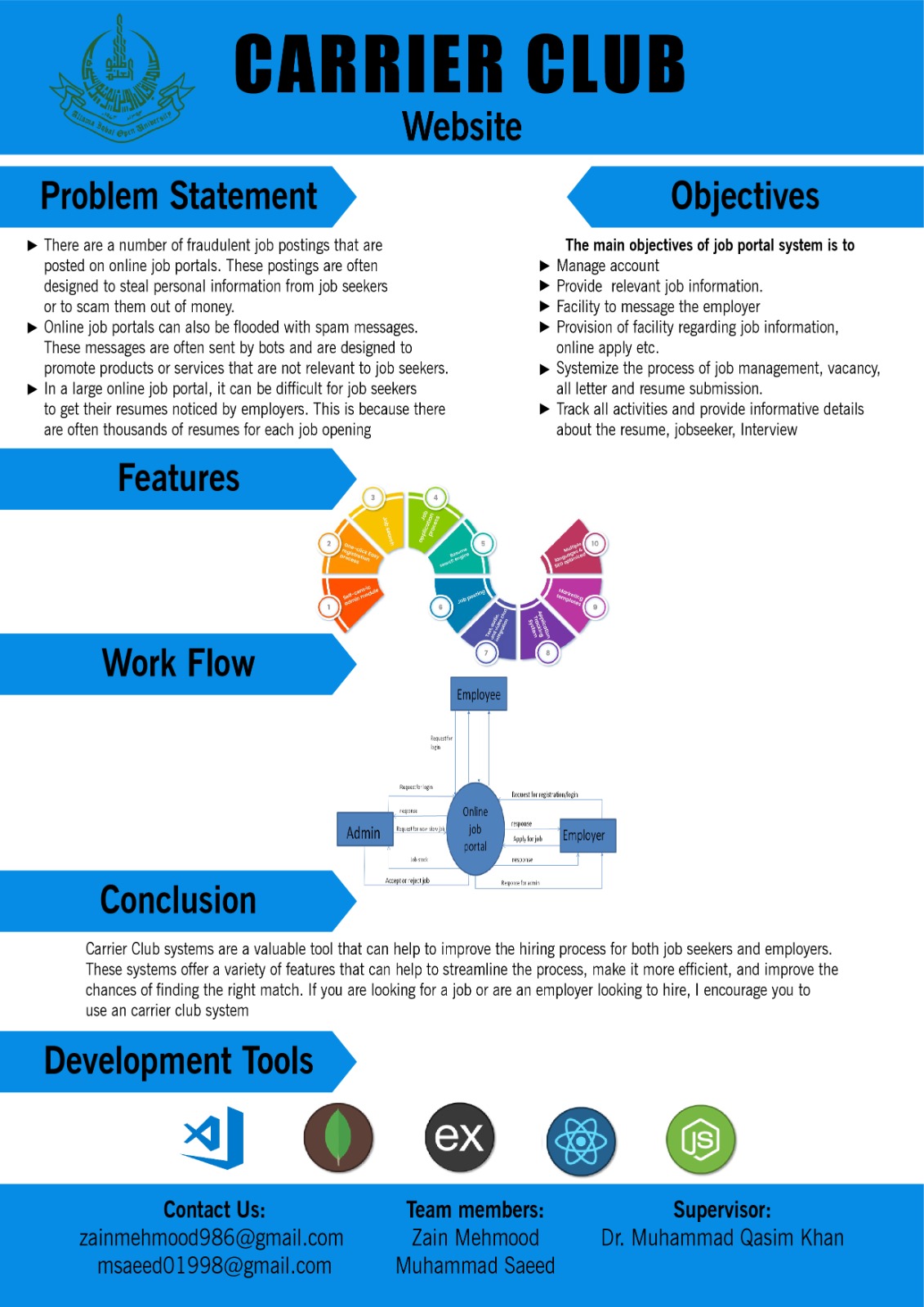
A carrier club is a website or online platform that posts job openings from various employers. Users of work entry can search for jobs, create profiles, and apply for positions. Work entrances can provide access to a variety of openings as well as the chance to communicate with managers and learn about available employment. Work entryways can provide employers with a platform to connect with a sizable group of job seekers as well as the tools to manage their job posts. The Profession Club framework is a crucial tool that can help job seekers and managers communicate with one another when looking for work. To meet the challenges of job seekers and businesses, the framework is always evolving, and it is undoubtedly.
The Online Health System Project is a comprehensive digital healthcare platform designed to revolutionize healthcare accessibility and management. This project aims to empower patients by providing them with easy access to medical services, including appointment scheduling, telemedicine consultations, and access to medical records. Healthcare providers benefit from streamlined patient management and improved communication through secure messaging and real-time data access. Additionally, the system incorporates advanced data analytics to support evidence-based decision-making and improve overall healthcare outcomes. With a focus on user-friendly interfaces and robust security measures, this project represents a significant step toward
Inefficient FYP process: time wastage, student-supervisor communication gap, and progress obstacles.
Objectives
Develop a web-based solution tailored for BSCS and DCS students at AIOU, streamlining FYP submission, progress tracking, and faculty reviews, addressing completion challenges and enhancing student-supervisor communication.
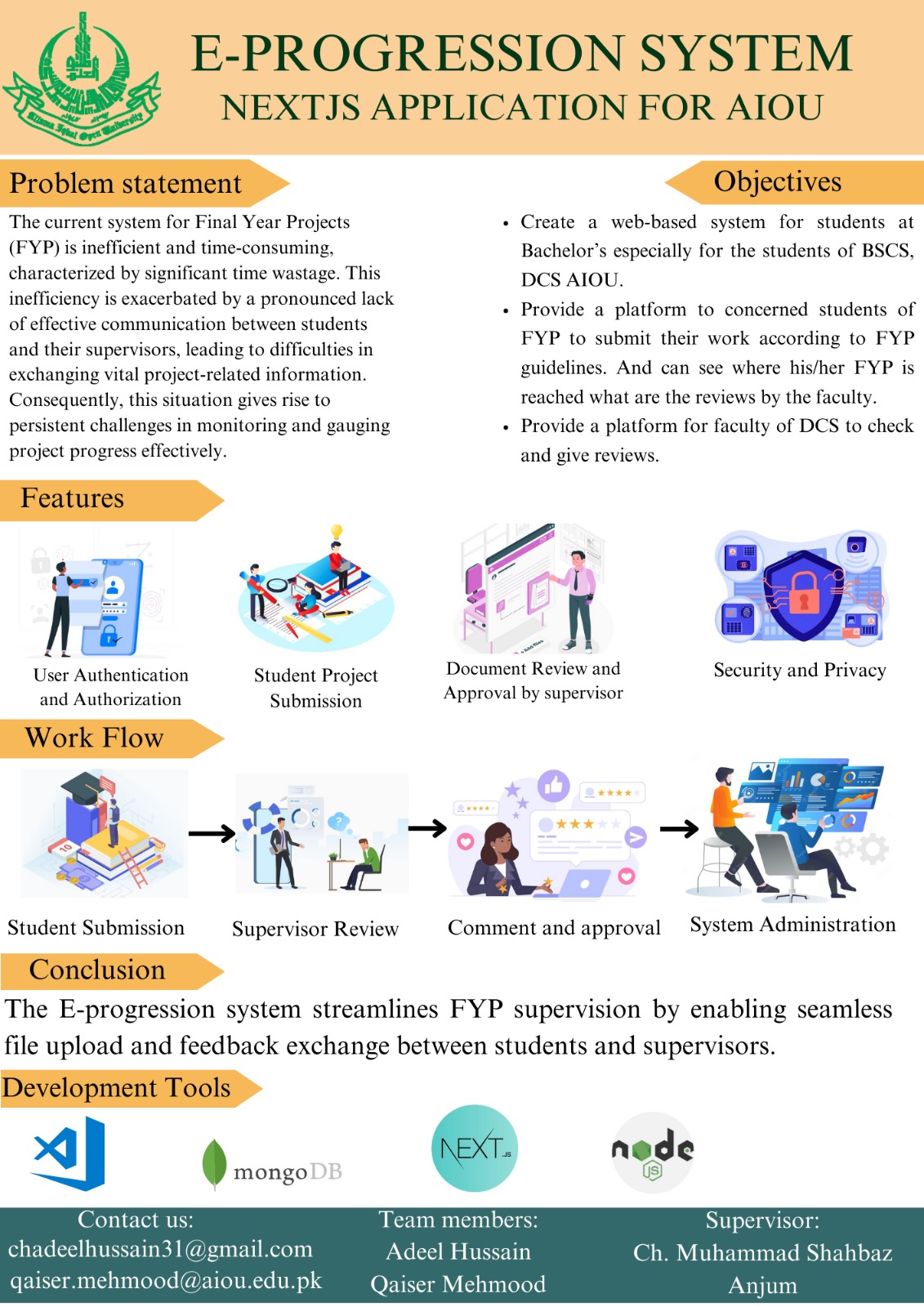
The abstract outlines a web-based system designed specifically for BSCS and DCS students at AIOU, aimed at optimizing the process of Final Year Project (FYP) management. The system offers a platform for students to submit their FYP work in alignment with guidelines, enabling them to monitor their project's progress and access faculty reviews. Additionally, the system provides a channel for DCS faculty to assess and provide feedback on FYPs. Its purpose extends to assisting students who encounter challenges in FYP completion and fostering improved communication between students and their supervisors, ultimately enhancing the FYP experience.


